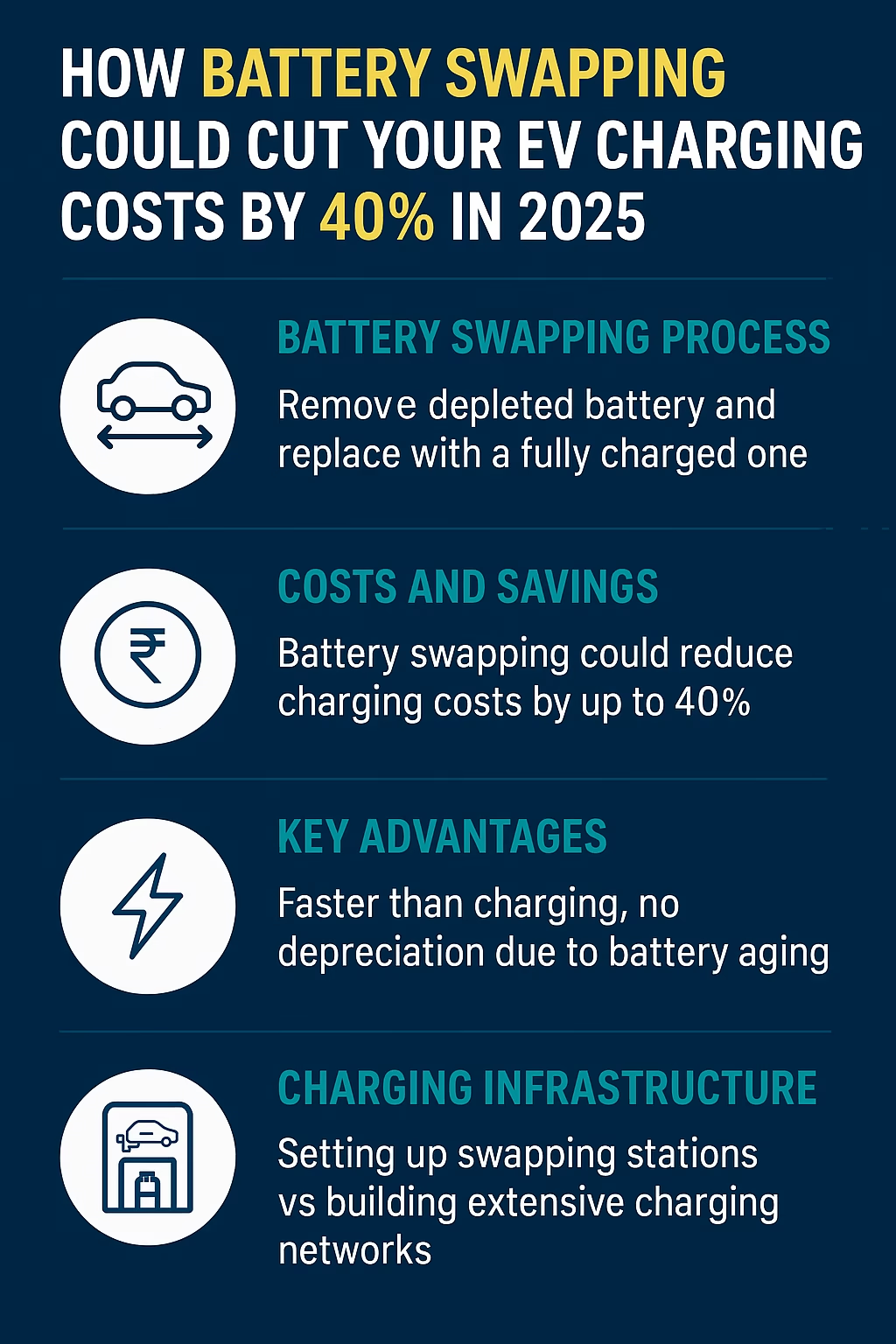Table of Contents
Introduction—The EV Charging Problem Nobody Talks About
In India and around the world, electric vehicles, or EVs, are quickly taking over as the mode of transportation of the future. However, high charging costs and lengthy charging times continue to be a major annoyance for many drivers. Home charging isn’t always feasible, especially for people who live in urban apartments, and fast charging stations are frequently pricey.

This is where battery swapping comes into play. By 2025, this technology has the potential to cut your EV charging costs by 40% and revolutionize the way we power our EVs. But why is it such a game changer, and how does it operate exactly? Let’s get started.
What Is Battery Swapping?
Battery swapping is a straightforward but revolutionary idea: you go to a swap station, take out your depleted battery, and replace it with a fully charged one in a matter of minutes rather than plugging in your EV and waiting for hours.
Think of it like LPG cylinder exchanges—fast, convenient, and hassle-free. And the best part? It’s a system that can drastically cut your EV charging costs by 40% in 2025.
Why Charging Costs Are So High Right Now
To understand the cost benefits of battery swapping, let’s break down why EV charging is expensive today:
- Fast Chargers Use Premium Electricity Rates – High-capacity DC fast chargers consume a lot of power in a short time, which raises operating costs.
- Battery Degradation Costs – Frequent fast charging can reduce battery life, meaning owners must budget for costly replacements.
- Idle Time Losses—While your EV is charging, you’re essentially waiting—time that could be used for work, travel, or leisure.
Battery swapping solves these issues by separating battery ownership from vehicle ownership, creating a more efficient cost-sharing model.
How Battery Swapping Works in 2025
In 2025, battery swapping networks will be far more advanced. Here’s a step-by-step process:
- Arrive at a Swapping Station—Much like a petrol pump, stations are strategically located in cities and highways.
- Automated Battery Removal – Robots or automated lifts remove your old battery.
- Fresh Battery Installation – A fully charged battery, already maintained and optimized, is installed instantly.
- Digital Payment & Tracking – Apps track battery usage, mileage, and payment plans.
This system ensures you always have a well-maintained battery without worrying about degradation or replacement costs.
The Math—How It Could Cut Your EV Charging Costs by 40% in 2025
Here’s a quick cost comparison:
| Charging Method | Cost per kWh (avg.) | Annual Cost (15,000 km) |
|---|---|---|
| Home Charging | ₹8-10 | ₹18,000 – ₹22,500 |
| Fast Charging | ₹15-18 | ₹33,750 – ₹40,500 |
| Battery Swapping | ₹9-11 | ₹20,250 – ₹24,750 |
That’s a 40% saving compared to using only fast chargers—plus the bonus of avoiding battery replacement expenses.
Benefits Beyond Cost Savings
While the ability to cut your EV charging costs by 40% in 2025 is compelling, battery swapping offers more:
- Time Savings – Just 3-5 minutes per swap.
- Battery Longevity – Shared batteries are charged optimally, extending life.
- Environmental Gains – Centralized charging allows better use of renewable energy.
- Scalability—Perfect for fleets like taxis, delivery bikes, and buses.
Major Players in the Battery Swapping Market
Several companies are racing to dominate this space:
- SUN Mobility—already deploying battery swapping for electric scooters and three-wheelers in India.
- Ola Electric – Exploring battery swapping stations for two-wheelers.
- Gogoro—The Taiwanese giant entering India with its scooter battery swap network.
- NIO – China’s first automated auto battery swap station.
As these companies expand, expect the number of swap stations to rival petrol pumps in urban areas by 2025.
Best Highway Routes in India with Reliable Fast EV Charging in 2025
Government Push and Policies
The Indian government is actively encouraging battery swapping under its EV policy:
- FAME-II Incentives – Subsidies for EVs with swappable batteries.
- Standardization of Battery Packs—Ensuring interoperability between brands.
- Urban Planning Integration – Mandating EV swap points in new developments.
With this push, the goal of cutting your EV charging costs by 40% in 2025 becomes even more realistic.

Challenges That Still Need to Be Solved
While promising, battery swapping faces some hurdles:
- Standardization Issues—Different EV makers use different battery shapes and specs.
- Initial Infrastructure Costs—Setting up automated swap stations is expensive.
- Consumer Trust—Drivers must feel confident in using shared batteries.
However, as technology improves and adoption increases, these challenges are expected to diminish.
Battery Swapping vs Fast Charging The Real Winner
| Feature | Battery-Swapping | Fast-Charging |
|---|---|---|
| Speed | 3-5 minutes | 30-60 minutes |
| Cost per kWh | Low-Medium | High |
| Battery Life Impact | Low | High |
| Scalability | High | Medium |
For frequent drivers, fleet operators, and urban commuters, battery swapping will clearly be the smarter choice in 2025.
Real-Life Example – The Ola Delivery Rider
Meet Rajesh, an Ola delivery partner in Bengaluru. He drives an electric scooter 80 km daily. Before battery swapping, he spent ₹3,500 a month at fast charging stations. After shifting to a battery subscription plan, his costs dropped to ₹2,000—a saving of nearly 43%, right in line with the promise to cut your EV charging costs by 40% in 2025.
The Future Outlook
By the end of 2025, analysts predict:
- 50,000+ swap stations across India.
- EV adoption to jump to 15% of all new vehicles sold.
- Major automakers are integrating standardized swappable batteries.
This growth will not only lower costs but also make EV ownership more practical for millions.
Conclusion—A Smarter, Cheaper EV Future
Battery swapping is more than a convenience—it’s a cost-cutting revolution. With the potential to cut your EV charging costs by 40% in 2025, it addresses the biggest barriers to EV adoption: high charging costs, long wait times, and battery degradation.
The EV revolution isn’t just about going electric—it’s about going smart. And in 2025, smart drivers will be swapping, not charging.
FOLLOW TIME OF HINDUSTAN ON FB

[…] How Battery Swapping Could Cut Your EV Charging Costs by 40% in 2025 […]